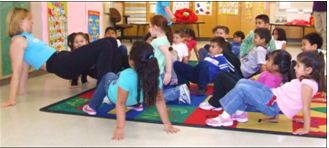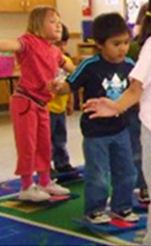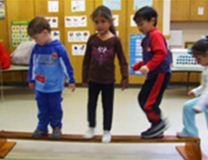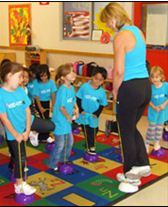Physical Therapy Corner: Improving Balance in Preschool Children
By: Michele Silence, MA, KidFit
Balance is a skill necessary for lifelong health. A good sense of balance requires that muscles are able to control posture and keep the body upright. Being on balance is the process of controlling the body’s center of mass. Or quite simply, not falling down. Static balance refers to maintaining equilibrium while holding still. Dynamic balance refers to maintaining equilibrium while moving.
It’s crucial that preschool children acquire a good sense of balance. They need to practice a variety of challenging exercises especially in regards to dynamic balance because it’s so crucial in being competent with physical skills later on. Throwing, catching, jumping and other gross motor activities require a child to be able to maintain their center of gravity. Balance is the foundation for a healthy life filled with movement.
Three sensory systems are responsible for controlling dynamic balance. First, the body must be able to perceive where it is in space. The somatosensory system allows a child to sense where their body is in space. It provides information regarding the position and movement of body parts in relation to one another. The visual system gives feedback on body location in relation to objects in the environment. The vestibular system, located in the inner ear, helps determine whether the body or the world is moving. It becomes extremely important in helping maintain balance when the other two systems are impaired. Children with impairments in any of these three systems may need extra help and time to improve stability.
Balance is developed in stages. Stephen Sanders (Designing Preschool Movement Programs, 1992) lists the following as successive stages children will normally pass through while they perfect their ability to balance. Each stage builds upon what is learned in the previous one.
- Balancing on body parts
- Balancing on wobble boards
- Balancing on low balance beams
- Standing and walking on small stilts
- Walking on high beams

Balancing on body parts is the most basic. This is just maintaining balance in different planes while controlling weight distribution. Figure 1 (above) shows how children are using static balance on a wide base of support. You can practice this with children and make it progressively more difficult by placing hands on the floor while attempting to lift one leg or even one leg and one arm. Eventually place a bean bag somewhere on the body to add a little more challenge. For example, place a bean bag on the shoulder while standing on one leg or on a lifted knee while both hands are on the nose.

Balancing on wobble boards requires manipulating equipment while attempting to adjust to changes in the center of gravity (see Figure 2 above). You can make a simple wobble board by attaching a wooden strip underneath the length of a square board along the midline. When children stand on the board, they must teeter from one side to the other to learn how to maintain balance directly in the middle. Or place their feet in the middle and try to maintain balance while not shifting weight to either side, such as in a surfing type motion.

Balancing on a low balance beam adds the dimension of height. Children can walk on top of a short plank, a large knotted rope or half foam rollers. All require the body to remain stable while locomoting above ground level. Try moving sideways, forward and backwards to increase challenge. Figure 3 above shows an example.

Standing and walking on small stilts is even more challenging. Have children bring in large tuna cans or short, stocky soup cans and make their own stilts to keep onsite for practice. You’ll need to help with puncturing the can, making sure there are no sharp edges, taping the edges and attaching a rope – or delegate the task as an at-home activity that children can do with their parents. You can also forgo the cans completely and use readymade stompers or sturdy domes, as shown in Figure 4 above.
Walking on high beams is the most advanced stage. Walking on a beam takes the experience off the ground. Be sure to have children supervised whenever practicing exercises on a high beam and provide thick mats underneath for safety. Limit height to no more than 30 inches above ground level.
Once children have mastered all of the above, you’ll be able to challenge them even more by adding movements such as hopping on one foot, doing patterned jumping (outdoor hopscotch drawn with chalk is always fun), leaping from one spot to another and bouncing on a mini trampoline.
Whether children are advanced in their abilities, average, developmentally delayed or permanently impaired, you can help them improve both static and dynamic balance from whatever stage they are starting at. Improving this skill will increase their enjoyment of basic physical activities.
Love for movement is exactly what all children need to help combat childhood obesity, reduce risk factors for heart disease, prevent type 2 diabetes and curb other diseases brought on by sedentary lifelong habits. Try some of the exercises shown and you’ll see children laugh, have fun and develop this important skill without even knowing it!
This Month’s Featured Author and Organization: Michele Silence, M.A. of KidFit
Michele Silence, M.A. is a 25-year fitness professional, trainer, educator, studio owner and freelance writer serving as an advisory board member for P.E. Central. Her articles have appeared in Fitness Management, The IDEA Journal, The DietChannel.com and numerous Op-Ed news columns. She is the President and CEO of Aerobic Fitness Consultants, and the creator of KID-FIT, physical education classes for preschoolers. KID-FIT has been piloted nationwide, featured in the L.A. Times, and is taught around the world. Contact Michele at KidFit or via email at [email protected].
PediaStaff is Hiring!
All JobsPediaStaff hires pediatric and school-based professionals nationwide for contract assignments of 2 to 12 months. We also help clinics, hospitals, schools, and home health agencies to find and hire these professionals directly. We work with Speech-Language Pathologists, Occupational and Physical Therapists, School Psychologists, and others in pediatric therapy and education.
